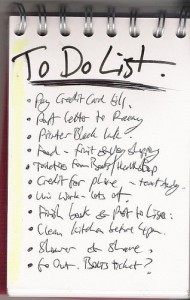I am a self-confessed list-making addict. I thrive on lists. Making lists allows me to visualize what I have to do, keep track of a hundred and one things and best of all, helps me actually accomplish them. I love it when I can check something off my list.
Please don’t misunderstand my love of lists. I’m as spontaneous as the next person. It’s just that in this day and age, when everyone is juggling multiple roles and responsibilities, life can very quickly become overwhelming. Making lists allows me to break down my errands, responsibilities, to-do lists, goals and projects into manageable chunks and prevents an otherwise eminent nervous breakdown.
Lists can range from the five-year plan to the weekend list, or the “things to do tomorrow” list that I inevitably write up just before going to bed. There are those who will scoff at the idea of writing one’s daily activities on a piece of paper (or smartphone if you’re tech-savvy). But there are others, like me, who absolutely need to make lists. (You know who you are.)
I’ve stumbled across a few ways to take list-making to whole new level of efficiency. Whether you are a new or experienced list-maker or someone simply looking for a way to bring some organization into your life, here are 5 ways to help you master the art of making lists.
Get a notebook or diary
You don’t necessarily need a physical notebook; you can create a document on your computer or use a virtual notepad on your phone.The important thing is that you have a dedicated place to compile lists- it needs to be easily accessible and something you will actually use. For a long time, I used a semi-efficient system of coloured post-its stuck to my desk.
You can also split your lists by category. At work, you could use a task list on your desktop and for personal projects, you could use a pocket notebook that you carry around. Figure out a system that works for you.
Make your lists achievable
Every list should be realistic. If you list down 50 things to get done in one day, you’re setting yourself up for disappointment. Similarly, a daily list that has multiple tasks that are big in scope is not the best morale booster.
It might be helpful to create a “master” list for, let’s say, a month. Break that list down into weekly goals and then again into daily activities. Doing this can help you identify smaller, achievable tasks that are working towards larger goals. The benefit is that you won’t be overwhelmed by trying to “Find a Job” in one day.
Instead, “Find a Job” can be broken down into:
- Identify the industries I would like to work in
- Find 5 job postings in the field I want to work in
- Update resume
- Write a cover letter
- E-mail a contact at Company X
- Ask Person Y about any openings at their company
- Subscribe to the job alerts for Organization Z
Assign times to your tasks
Understand what you are capable of by assigning a time allocation to each task.
If you have “Write a cover letter” on your to-do list, think about the amount of time you need to successfully complete it. If you think you need about two hours, write that time allocation next to the task on your list. By doing this for each task, you can get a better understanding of how much you can hope to accomplish in a day. You are less likely to over-schedule and more likely to actually achieve what you set out to do. And that’s always a great feeling.
If you feel up to it, you can go one step further and assign a time of the day to the task. For example:
10 am – Noon: Write a cover letter (2 hours)
Move unfinished tasks forward
If you find that you have not accomplished a specific task, move it forward to your new list. By doing so, you avoid forgetting about it. This is where it is helpful to have a notebook. You can look back at previous lists and re-evaluate what you still need to get done. Similarly, if an item on your list becomes redundant, remove it. Don’t carry forward unnecessary tasks.
Monday
Identify the industries I would like to work in
Find 5 job postings in the field I want to work in- Update resume
Write a cover letter- E-mail a contact at a company
Tuesday
- Ask Person Y about any openings at their company
- Subscribe to the job alerts for Organization Z
- Update resume ( from Monday’s list )
- E-mail a contact at Company X ( from Monday’s list )
Be flexible
The list is not set in stone, it is merely a tool to help you achieve your goals and accomplish tasks. For instance, if you get a call back for an interview, you will need to schedule that in and that may require moving things around. If you don’t cross anything off your lists for a couple of days, don’t sweat it. Take a moment to think about what you still need to get done and re-evaluate how to go about it.
Remember, you are in charge of your lists – not the other way around. Even though list-making is a great way to stay on top of tasks and activities, there is too much of a good thing. It’s important to keep some perspective. So when I go on vacation, I store all my lists away in a folder – not to be thought of until I return.